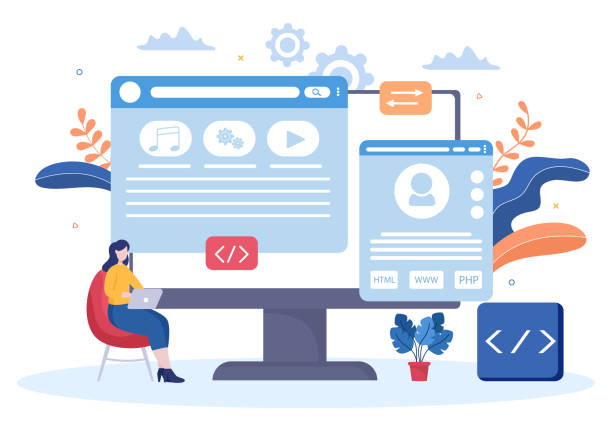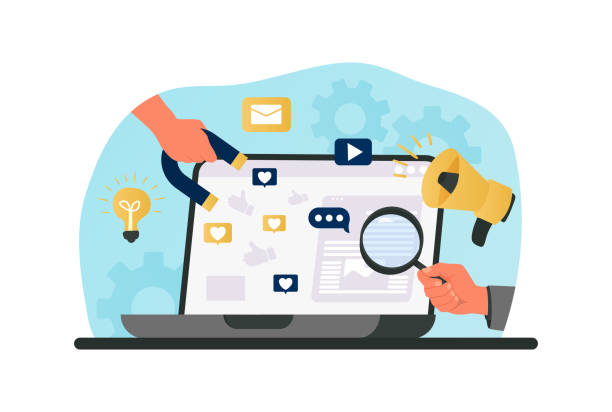Introduction and the Importance of Secure Website Design in the Digital World

In the current era, where a vast portion of daily activities, from buying and selling to communications and banking, has shifted to the online space, #web_security and #data_protection are of vital importance.
#Secure_website_design is no longer a luxury option, but an undeniable necessity for any business or individual intending to have an effective presence on the internet.
Cyber threats such as #cyber_attacks, data theft, and system intrusions are becoming increasingly complex and widespread day by day.
Ignoring this issue can lead to loss of user trust, heavy financial losses, and even damage to brand reputation.
Imagine an #e-commerce website, without adhering to secure website design principles, exposing its customers’ credit card information to risk; this event would not only harm customers but also face the business with a serious crisis.
Therefore, every web development project should begin with a security approach from the outset, and security should be considered as a core component throughout all stages of the Software Development Life Cycle (SDLC).
This includes choosing secure platforms, secure coding, and proper server configuration.
Secure website design is the backbone of a successful and sustainable online presence and can make the difference between a successful business and an online disaster.
Hence, investing in this area is not just an expense, but an investment for the future.
Are you tired of your e-commerce site having visitors but no sales? RasaWeb solves your main problem with professional e-commerce website design!
✅ Significant increase in sales with targeted design
✅ Seamless user experience for your customers
⚡ Get a free consultation!
Basic Principles in Secure Website Design and Secure Coding

#Secure_coding and adherence to #security_standards are the cornerstones of any secure and stable website design.
The first step in this direction is to educate and raise awareness among developers about common web vulnerabilities and ways to prevent them.
Organizations like OWASP (Open Web Application Security Project) publish a comprehensive list of the top 10 web vulnerabilities that every developer should be familiar with.
One of the most important principles is “Input Validation”; meaning that any data received from the user must be carefully checked and sanitized to prevent the injection of malicious code or invalid data.
For example, if you expect a number, you must ensure that the input is indeed a number and not an injected SQL string.
Another principle is “Strong Authentication” and “Session Management”.
Using complex passwords, two-factor authentication (2FA), and secure session tokens are among the vital solutions.
Sensitive user information should never be stored without encryption; even passwords should be stored as hashed (Hash) using strong algorithms.
Also, the “Principle of Least Privilege” states that every user or component in the system should only have access to the minimum resources necessary to perform its tasks.
This approach helps limit the scope of attacks in case of a breach.
To ensure secure website design, updated and reputable frameworks and libraries that have built-in security features should be used.
Ignoring these principles can make your website highly vulnerable to cyber threats.
Common Risks and Prevention Methods in Web Development

In the path of #secure_web_development, understanding and combating common risks is of high importance.
#Secure_website_design requires a deep understanding of attacker techniques and the implementation of appropriate defensive mechanisms.
Three of the most common and destructive vulnerabilities are: SQL Injection, Cross-Site Scripting (XSS), and Cross-Site Request Forgery (CSRF).
SQL Injection occurs when an attacker injects malicious SQL code into the database through user inputs, thereby gaining access to sensitive information or modifying it.
To prevent it, Prepared Statements or ORMs should be used, which properly separate parameters from SQL codes.
XSS allows an attacker to inject malicious script codes into web pages, which are executed in the victim’s browser and can lead to the theft of cookies or session information.
The main solution is “Output Encoding”, meaning that all data displayed in the browser must be properly encoded.
CSRF happens when an attacker tricks a user into sending an unwanted request to a legitimate website while the user is already authenticated.
CSRF tokens, referrer checking, and custom headers are effective solutions for countering these attacks.
| Attack Type | Brief Description | Main Prevention Method |
|---|---|---|
| SQL Injection | Injecting malicious SQL codes into the database | Prepared Statements / ORM |
| Cross-Site Scripting (XSS) | Injecting malicious scripts into web pages | Output Encoding / Sanitization |
| Cross-Site Request Forgery (CSRF) | Tricking the user into sending unwanted requests | CSRF Tokens / SameSite Cookies |
| Broken Authentication | Weaknesses in authentication mechanisms | MFA / Strong Passwords / Session Management |
In addition to these, there are other risks such as “Brute Force attacks”, “Directory Traversal” and “XML External Entities (XXE)”, each requiring its own specific defensive approaches.
A secure website design should adopt a multi-layered approach (Defense in Depth) to cover these vulnerabilities.
Generally, keeping technical knowledge up-to-date, using static code analysis (SAST) and dynamic analysis (DAST) tools, and conducting regular penetration tests are essential measures for maintaining a website’s security.
This is an ongoing process, and web security never reaches an end point.
The Role of SSL/TLS Certificates in Website Security and Credibility

One of the most prominent symbols of #online_trust and #data_security on the web is the presence of an SSL/TLS certificate.
When a website uses HTTPS (Hypertext Transfer Protocol Secure) instead of HTTP, it means that the communication between the user’s browser and the website’s server is encrypted.
This encryption is performed by SSL/TLS (Secure Sockets Layer/Transport Layer Security) certificates.
SSL/TLS prevents eavesdropping, data manipulation, and identity spoofing by creating a secure tunnel.
These certificates are issued by Certificate Authorities (CAs) and guarantee that you are genuinely communicating with the intended website and not a fake one.
For secure website design, implementing SSL/TLS is crucial, especially for websites that collect sensitive information such as personal details, passwords, or credit card information.
Without SSL/TLS, any data exchanged between the user and the server is visible as plain text and can easily be intercepted by attackers.
In addition to security, the presence of an SSL/TLS certificate also impacts SEO.
Search engines like Google prefer HTTPS-enabled websites in their search results rankings.
This not only helps increase site traffic but also boosts user trust and improves the user experience.
There are various types of certificates, from DV (Domain Validated) certificates that only verify the domain, to EV (Extended Validation) which offer a high level of organizational identity verification.
The choice of certificate type depends on the website’s security and desired credibility needs.
Does your company website perform as your brand deserves? In today’s competitive world, your website is your most important online tool. RasaWeb, specializing in professional corporate website design, helps you to:
✅ Build credibility and customer trust
✅ Convert website visitors into customers
⚡ Get a free consultation!
Continuous Website Updates and Maintenance for Security Preservation

#Website_security is not a static state, but a dynamic and continuous process.
Secure website design not only means correct initial implementation but also depends on #continuous_maintenance and regular updates.
Attackers are constantly discovering new vulnerabilities in software, frameworks, and Content Management Systems (CMS).
Therefore, ignoring updates can make your website vulnerable to new attacks.
This includes updating the core CMS (such as WordPress, Joomla, Drupal), all plugins, themes, and also server software (such as PHP, Apache, Nginx, MySQL).
Many successful cyberattacks occur not through complex attacks, but by exploiting known vulnerabilities for which patches have been released long ago but have not yet been applied.
In addition to software updates, continuous monitoring of server logs to identify suspicious and unusual activities is also essential.
Logs can provide valuable information about intrusion attempts, Brute Force attacks, or unauthorized access.
Planning for regular and automatic backups of the entire website (files and database) also is a critical component of the security strategy.
In case of an attack or system failure, an up-to-date backup can significantly reduce recovery time and minimize data loss.
Furthermore, using a Web Application Firewall (WAF) can provide an additional defensive layer against common attacks.
Remember that web security is an ongoing race between attackers and defenders; by staying updated and actively maintaining, you can always be one step ahead and maintain a secure online platform.
Penetration Testing and Vulnerability Assessment; Discovering Weaknesses Before Attackers

After implementing the principles of secure website design, the next step to ensure defensive robustness is to conduct #penetration_testing and #vulnerability_assessment.
These processes are proactive approaches to identify weaknesses and security holes in a website before they are discovered and exploited by attackers.
Vulnerability assessment involves using automated tools to scan systems and applications to find known vulnerabilities.
These tools can identify thousands of security weaknesses in a short period and provide a comprehensive report on them.
However, penetration testing goes a step further. In penetration testing, security specialists (also known as “ethical hackers”), using the same methods and tools employed by real attackers, attempt to penetrate systems.
Their goal is to simulate a real attack not only to discover vulnerabilities but also to assess the potential impact and extent of a successful attack.
This process can include black-box testing (without prior knowledge of the system), grey-box testing (with limited knowledge) and white-box testing (with full access to code and infrastructure).
The penetration test report will include details of the vulnerabilities found, their severity, and practical recommendations for resolving each one.
Performing periodic penetration tests, especially after major changes in code or infrastructure, is essential for maintaining website security.
This activity allows you to fix potential weaknesses in a controlled environment, without being exposed to real-world threats.
In summary, penetration testing is not only a tool for discovering vulnerabilities but also an educational process for the development team, helping them prevent the recurrence of security errors in the future.
Database Security and User Access Management

#Database_security is the backbone of any secure website design, as most sensitive and critical website information is stored there.
Successful database attacks can lead to customer data theft, loss of operational data, and even complete service shutdown.
The first step in securing a database is encrypting data both at rest and in transit.
Sensitive data must be encrypted before being stored in the database, and communication between the web application and the database must also be established through secure channels (such as SSL/TLS).
The second principle is “Access Management” with a “Least Privilege” approach.
This means that each user or application should only have access to the minimum data and functionalities necessary to perform their tasks.
For example, a regular user should not have access to administrative tables or data deletion.
Also, using strong and unique passwords for database accounts, and regularly changing them, is essential.
Monitoring database activities through security logs can help identify suspicious access patterns and intrusion attempts.
The use of Database Firewalls can also provide another security layer against SQL injection attacks and other threats.
Secure website design includes protecting backend data, not just the website’s appearance.
| Database Security Topic | Description | Importance / Actions |
|---|---|---|
| Data Encryption | Protection of data at rest and in transit | Essential for sensitive information (credit card, password) |
| Access Management | Defining access levels for users and applications | Principle of least privilege, role separation |
| Database Network Security | Isolating the database in a separate network | Using firewalls, VPN, VLAN |
| Backup and Recovery | Creating regular backups for quick recovery | Crucial for business continuity in case of disaster |
Furthermore, the use of robust backup and recovery mechanisms minimizes data loss in the event of an attack or failure.
Backups should be taken regularly and stored in a secure and separate location.
Ensuring that backups are recoverable is equally important.
Finally, continuous training for the development team on best database security practices, as well as conducting regular security audits, are considered key measures for maintaining a secure website structure.
Database security should never be overlooked.
User Education and the Importance of Awareness in the Security Chain

#Human_factor is often recognized as one of the greatest #security_vulnerabilities in any system.
Even if you have a flawless secure website design, an uninformed user can inadvertently open a path for attackers.
Therefore, educating users and increasing their awareness of cyber threats is an inseparable part of a comprehensive cybersecurity strategy.
These trainings should include topics such as: the importance of using strong and unique passwords for each service, enabling two-factor authentication (2FA) for all accounts, and awareness of phishing and social engineering attacks.
Phishing attacks are carried out through fake emails, messages, or websites that impersonate legitimate entities to steal sensitive user information.
Educating users to identify signs of phishing, such as suspicious email addresses, typos, and unusual requests, is crucial.
They should also be encouraged never to click on suspicious links or open unknown attachments.
Furthermore, users should be aware of the importance of connecting to insecure public Wi-Fi networks and their potential risks.
A secure online platform is not only technically robust but also has an aware user community that helps maintain its security.
Providing engaging and entertaining educational content, such as games, short videos, or interactive infographics, can help increase user participation in this process.
Ultimately, fostering a culture of security within the organization and among users, through regular training workshops and the dissemination of security newsletters, can help create a safer online environment for everyone.
Security is everyone’s shared responsibility.
Tired of losing customers due to poor e-commerce website design?
With RasaWeb, solve this problem forever!
✅ Increase sales and visitor-to-customer conversion rates
✅ Smooth and engaging user experience for your customers⚡ Get a free consultation
Responding to Security Incidents and Planning for Recovery

Regardless of how diligent you are in secure website design and what defensive measures you implement, the probability of a security incident never reaches zero.
#Incident_Response and #Disaster_Recovery_Planning are vital components of a comprehensive security strategy.
This means there must be a documented and predefined plan for when a cyberattack occurs.
This plan includes the stages of identification, containment, eradication, recovery, and lessons learned from the incident.
Rapid incident identification is of high importance; the sooner an attack is detected, the less potential damage there will be.
This requires active monitoring of systems and logs, and the use of Intrusion Detection Systems (IDS) and Intrusion Prevention Systems (IPS).
After identification, the next goal is to “contain” the attack to prevent its spread.
This can involve isolating infected systems from the network or blocking attacker IP addresses.
The “eradication” phase involves removing the attack agent from the system, patching vulnerabilities, and cleaning infected systems.
Then the “recovery” phase begins, during which systems are returned to normal operational status.
This phase relies on regular and recoverable backups.
Finally, the “lessons learned” phase involves analyzing the incident, identifying its root causes, and updating security policies and procedures to prevent its recurrence in the future.
Securing an online platform is not just about preventing attacks, but also about the ability to react quickly and effectively to them.
These plans must be regularly reviewed and tested to ensure they function correctly during a crisis.
A trained and experienced incident response team can make the difference between a minor disruption and a major catastrophe.
The Future of Secure Website Design and Emerging Challenges in the World of Technology

The world of #cybersecurity is rapidly evolving, and with technological advancements, #emerging_challenges also appear.
Secure website design in the future will require attention to new dimensions of threats and opportunities.
With the expansion of the Internet of Things (IoT) and the connection of countless devices to the internet, the attack surface has significantly increased.
Websites and platforms must be able to securely interact with these insecure devices.
Furthermore, advances in Artificial Intelligence (AI) and Machine Learning (ML) not only provide new tools for cyber defense, but attackers can also use them to automate attacks, identify vulnerabilities, and even create more sophisticated malware.
For example, AI-powered phishing attacks can be much more convincing and personalized.
The advent of quantum computing also poses a potential threat to current encryption algorithms.
While still in its early stages, in the future it could have the ability to break current encryptions and create a need for “post-quantum” algorithms.
This will require a complete overhaul of the encryption methods used in website development with a security approach.
On the other hand, increasing data privacy regulations such as GDPR in Europe and CCPA in California are forcing companies to adopt a “Privacy by Design” approach in secure website design, meaning that privacy must be considered from the very beginning throughout all development stages.
These challenges highlight the need for continuous innovation, international cooperation, and greater investment in security research.
The future of web security is one where adaptability and threat prediction play a central role.
Frequently Asked Questions
| No. | Question | Answer |
|---|---|---|
| 1 | What does secure website design mean? | Secure website design refers to a set of measures and methods employed to protect a website against cyberattacks, unauthorized access, data breaches, and other security threats. Its goal is to maintain the confidentiality, integrity, and availability of information. |
| 2 | Why is website security important? | Website security is vital for maintaining user trust, protecting sensitive information (such as personal and financial data), preventing financial losses, preserving brand reputation, and complying with legal regulations (such as GDPR). A security breach can lead to customer loss and heavy penalties. |
| 3 | What are some of the most common security attacks against websites? | Common attacks include SQL Injection, XSS (Cross-Site Scripting), CSRF (Cross-Site Request Forgery), Brute Force, DDoS attacks, Broken Authentication, and Missing Function Level Access Control. |
| 4 | What is the role of SSL/TLS certificates in website security? | SSL/TLS certificates (which lead to HTTPS addresses) are used for encrypting data exchanged between the user and the website server. This prevents eavesdropping or manipulation of sensitive information such as passwords and credit card details during transit and verifies the website’s authenticity. |
| 5 | How can SQL Injection attacks be prevented? | To prevent SQL Injection, Prepared Statements or ORM (Object-Relational Mapping) with validated parameters should be used. Additionally, careful filtering and validation of user inputs (Input Validation) and applying the principle of least privilege in the database are essential. |
| 6 | What is HTTP Strict Transport Security (HSTS) and how does it help with security? | HSTS is a web security policy that tells browsers to load the website only via an HTTPS connection, even if the user enters the address with HTTP. This prevents Downgrade attacks and cookie theft on public Wi-Fi networks. |
| 7 | What is the importance of regular software and plugin updates for website security? | Regular updates of the Content Management System (CMS), plugins, themes, and other software components of the site are crucial for patching discovered security vulnerabilities. Developers constantly release security patches, and failing to update can leave the site vulnerable to known attacks. |
| 8 | What measures can be taken to enhance the security of the site’s administration section (admin panel)? | Changing the default admin panel path, using strong passwords and two-factor authentication (2FA), restricting access to specific IPs, using CAPTCHA on login pages, monitoring logs, and continuous CMS updates are among these measures. |
| 9 | Why is filtering and validating user inputs (Input Validation) important? | Filtering and validating inputs helps prevent the injection of malicious code or unauthorized data through forms, URLs, or other user input sections. This prevents attacks like XSS and SQL Injection that exploit invalid inputs. |
| 10 | Name a few common tools or services for checking and enhancing website security. | Tools such as Web Application Firewalls (WAF), vulnerability scanners (e.g., Acunetix, Nessus), Intrusion Detection and Prevention Systems (IDS/IPS), CDN services with security features (e.g., Cloudflare), and periodic Penetration Testing can enhance site security. |
And other services of RasaWeb advertising agency in the field of advertising
Smart SEO: Transform online growth with Google Ads management.
Smart Link Building: A combination of creativity and technology to attract customers through custom programming.
Smart Custom Software: Transform online growth by optimizing key pages.
Smart Google Ads: Transform campaign management with SEO-driven content strategy.
Smart Custom Software: Transform customer behavior analysis with Google Ads management.
And over a hundred other services in the field of internet advertising, advertising consultation, and organizational solutions
Internet Advertising | Advertising Strategy | Advertorials
Sources
Website Security Basics
Educational Video: Efficient Website Design
Best Practices in Web Design
Secure Website Design Guide
💡 For your business to be seen and grow in the digital world, RasaWeb Afarin is your best companion. From professional WordPress website design to search engine optimization (SEO) and smart social media management, we provide everything you need for your online brilliance with high expertise and experience. Let your business shine powerfully in the web space and achieve its high goals.
📍 Tehran, Mirdamad Street, next to Central Bank, Southern Kazeroun Alley, Ramin Alley No. 6




